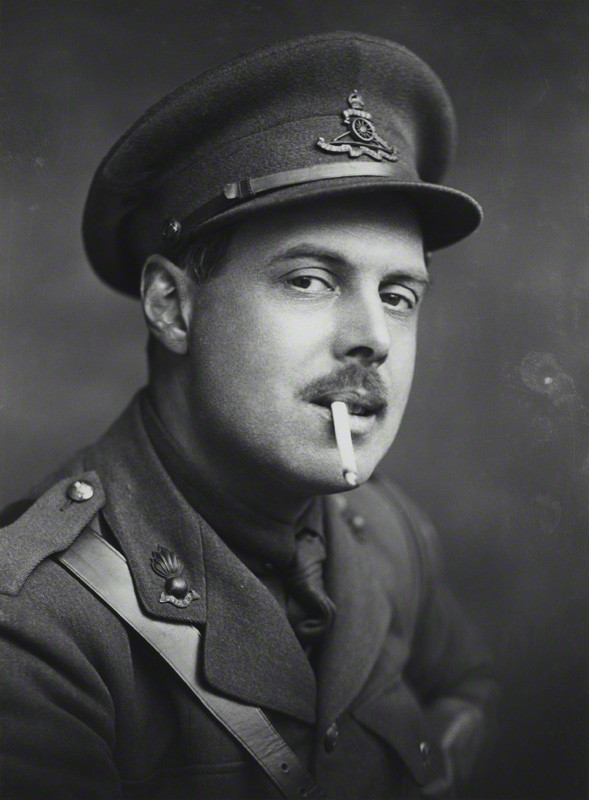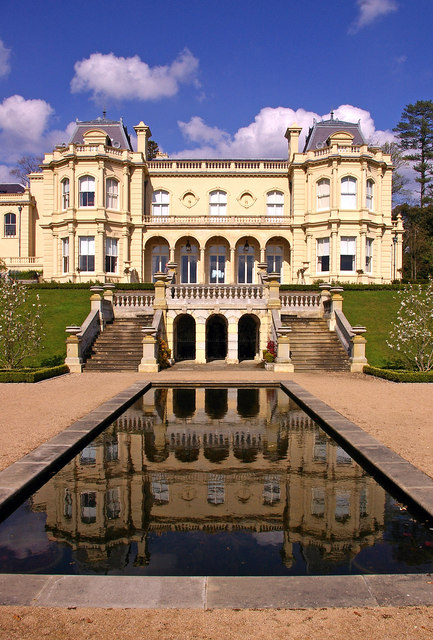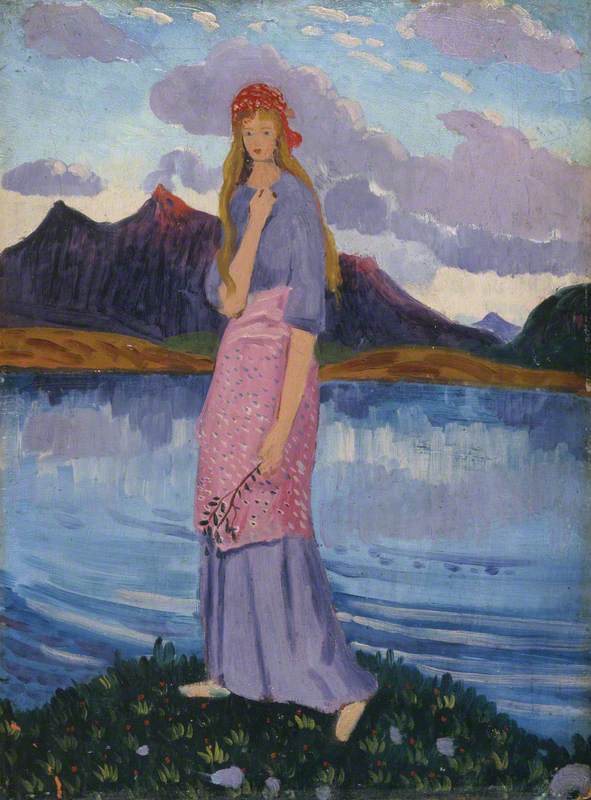|
Augustus John
Augustus Edwin John (4 January 1878 – 31 October 1961) was a Welsh painter, draughtsman, and etcher. For a time he was considered the most important artist at work in Britain: Virginia Woolf remarked that by 1908 the era of John Singer Sargent and Charles Wellington Furse "was over. The age of Augustus John was dawning." He was the younger brother of the painter Gwen John. Early life Born in Tenby, at 11,12 or 13 The Esplanade, now known as The Belgrave Hotel, Pembrokeshire, John was the younger son and third of four children. His father was Edwin William John, a Welsh solicitor; his mother, Augusta Smith, from a long line of Sussex master plumbers, died young when he was six, but not before inculcating a love of drawing in both Augustus and his older sister Gwen. At the age of seventeen he briefly attended the Tenby School of Art, then left Wales for London, studying at the Slade School of Art, University College London. He became the star pupil of drawing teacher Henry ... [...More Info...] [...Related Items...] OR: [Wikipedia] [Google] [Baidu] |
Time (magazine)
''Time'' (stylized in all caps) is an American news magazine based in New York City. For nearly a century, it was published Weekly newspaper, weekly, but starting in March 2020 it transitioned to every other week. It was first published in New York City on March 3, 1923, and for many years it was run by its influential co-founder, Henry Luce. A European edition (''Time Europe'', formerly known as ''Time Atlantic'') is published in London and also covers the Middle East, Africa, and, since 2003, Latin America. An Asian edition (''Time Asia'') is based in Hong Kong. The South Pacific edition, which covers Australia, New Zealand, and the Pacific Islands, is based in Sydney. Since 2018, ''Time'' has been published by Time USA, LLC, owned by Marc Benioff, who acquired it from Meredith Corporation. History ''Time'' has been based in New York City since its first issue published on March 3, 1923, by Briton Hadden and Henry Luce. It was the first weekly news magazine in the United St ... [...More Info...] [...Related Items...] OR: [Wikipedia] [Google] [Baidu] |
Pierre Puvis De Chavannes
Pierre Puvis de Chavannes (14 December 1824 – 24 October 1898) was a French people, French Painting, painter known for his mural painting, who came to be known as "the painter for France". He became the co-founder and president of the Société Nationale des Beaux-Arts, and his work influenced many other artists, notably Robert Genin, and he aided Medalist, medallists by designs and suggestions for their works. Puvis de Chavannes was a prominent painter in the early French Third Republic, Third Republic. Émile Zola described his work as "an art made of reason, passion, and will". Early life and education Puvis de Chavannes was born Pierre-Cécile Puvis in a suburb of Lyon, France, on December 14, 1824. He was the son of a mining engineer and descended from an old noble family of Burgundy (region), Burgundy. He later added the ancestral "de Chavannes" to his name. Throughout his life, he spurned his Lyon origins, preferring to identify himself with the 'strong' blood of the ... [...More Info...] [...Related Items...] OR: [Wikipedia] [Google] [Baidu] |
Augustus John Mit Tallulah
Caesar Augustus (born Gaius Octavius; 23 September 63 BC – 19 August AD 14), also known as Octavian, was the first Roman emperor; he reigned from 27 BC until his death in AD 14. He is known for being the founder of the Roman Principate, which is the first phase of the Roman Empire, and Augustus is considered one of the greatest leaders in human history. The reign of Augustus initiated an imperial cult as well as an era associated with imperial peace, the ''Pax Romana'' or ''Pax Augusta''. The Roman world was largely free from large-scale conflict for more than two centuries despite continuous wars of imperial expansion on the empire's frontiers and the year-long civil war known as the "Year of the Four Emperors" over the imperial succession. Originally named Gaius Octavius, he was born into an old and wealthy equestrian branch of the plebeian ''gens'' Octavia. His maternal great-uncle Julius Caesar was assassinated in 44 BC, and Octavius was named in Caesar's ... [...More Info...] [...Related Items...] OR: [Wikipedia] [Google] [Baidu] |
The Canadians Opposite Lens
''The'' () is a grammatical article in English, denoting persons or things already mentioned, under discussion, implied or otherwise presumed familiar to listeners, readers, or speakers. It is the definite article in English. ''The'' is the most frequently used word in the English language; studies and analyses of texts have found it to account for seven percent of all printed English-language words. It is derived from gendered articles in Old English which combined in Middle English and now has a single form used with pronouns of any gender. The word can be used with both singular and plural nouns, and with a noun that starts with any letter. This is different from many other languages, which have different forms of the definite article for different genders or numbers. Pronunciation In most dialects, "the" is pronounced as (with the voiced dental fricative followed by a schwa) when followed by a consonant sound, and as (homophone of pronoun ''thee'') when followed by a ... [...More Info...] [...Related Items...] OR: [Wikipedia] [Google] [Baidu] |
Wyndham Lewis
Percy Wyndham Lewis (18 November 1882 – 7 March 1957) was a British writer, painter and critic. He was a co-founder of the Vorticist movement in art and edited ''BLAST,'' the literary magazine of the Vorticists. His novels include ''Tarr'' (1918) and ''The Human Age'' trilogy, composed of ''The Childermass'' (1928), ''Monstre Gai'' (1955) and ''Malign Fiesta'' (1955). A fourth volume, titled ''The Trial of Man'', was unfinished at the time of his death. He also wrote two autobiographical volumes: '' Blasting and Bombardiering'' (1937) and ''Rude Assignment: A Narrative of my Career Up-to-Date'' (1950). Biography Early life Lewis was born on 18 November 1882, reputedly on his father's yacht off the Canadian province of Nova Scotia.Richard Cork"Lewis, (Percy) Wyndham (1882–1957)" ''Oxford Dictionary of National Biography'', Oxford University Press, 2004. His English mother, Anne Stuart Lewis (née Prickett), and American father, Charles Edward Lewis, separated about 1893. ... [...More Info...] [...Related Items...] OR: [Wikipedia] [Google] [Baidu] |
Lord Beaverbrook
William Maxwell Aitken, 1st Baron Beaverbrook (25 May 1879 – 9 June 1964), generally known as Lord Beaverbrook, was a Canadian-British newspaper publisher and backstage politician who was an influential figure in British media and politics of the first half of the 20th century. His base of power was the largest circulation newspaper in the world, the ''Daily Express'', which appealed to the conservative working class with intensely patriotic news and editorials. During the Second World War, he played a major role in mobilising industrial resources as Winston Churchill's Minister of Aircraft Production. The young Max Aitken had a gift for making money and was a millionaire by 30. His business ambitions quickly exceeded opportunities in Canada and he moved to Britain. There he befriended Bonar Law and with his support won a seat in the House of Commons at the December 1910 United Kingdom general election. A knighthood followed shortly after. During the First World War he ran th ... [...More Info...] [...Related Items...] OR: [Wikipedia] [Google] [Baidu] |
Gypsy Lore Society
The Gypsy Lore Society was founded in Great Britain in 1888 to unite persons interested in the history and lore of Gypsies and rovers and to establish closer contacts among scholars studying aspects of such cultures. History David MacRitchie was one of its founders in 1888 and he worked with Francis Hindes Groome until 1892 to produce its quarterly journal. From 1892, the organisation was dormant until its revival in 1907, when MacRitchie became its president. Another early member of the society was the explorer Sir Richard Burton, who wrote from Trieste in 1888: 1899 photo of R. A. Scott Macfie The Society had ceased to function during World War I. Robert Andrew Scott Macfie had set it up again round 1906 and John Sampson was its president of 1915. The Romani scholar Dora Esther Yates supported the society's revival in 1922 and she became its de facto secretary although this did not happen formally until 1932. Since 1989 it has been headquartered in the United States. Its ... [...More Info...] [...Related Items...] OR: [Wikipedia] [Google] [Baidu] |
Romani People
The Romani (also spelled Romany or Rromani , ), colloquially known as the Roma, are an Indo-Aryan ethnic group, traditionally nomadic itinerants. They live in Europe and Anatolia, and have diaspora populations located worldwide, with significant concentrations in the Americas. In the English language, the Romani people are widely known by the exonym Gypsies (or Gipsies), which is considered pejorative by many Romani people due to its connotations of illegality and irregularity as well as its historical use as a racial slur. For versions (some of which are cognates) of the word in many other languages (e.g., , , it, zingaro, , and ) this perception is either very small or non-existent. At the first World Romani Congress in 1971, its attendees unanimously voted to reject the use of all exonyms for the Romani people, including ''Gypsy'', due to their aforementioned negative and stereotypical connotations. Linguistic and genetic evidence suggests that the Roma originated ... [...More Info...] [...Related Items...] OR: [Wikipedia] [Google] [Baidu] |
Provence
Provence (, , , , ; oc, Provença or ''Prouvènço'' , ) is a geographical region and historical province of southeastern France, which extends from the left bank of the lower Rhône to the west to the Italian border to the east; it is bordered by the Mediterranean Sea to the south. It largely corresponds with the modern administrative region of Provence-Alpes-Côte d'Azur and includes the departments of Var, Bouches-du-Rhône, Alpes-de-Haute-Provence, as well as parts of Alpes-Maritimes and Vaucluse.''Le Petit Robert, Dictionnaire Universel des Noms Propres'' (1988). The largest city of the region and its modern-day capital is Marseille. The Romans made the region the first Roman province beyond the Alps and called it ''Provincia Romana'', which evolved into the present name. Until 1481 it was ruled by the Counts of Provence from their capital in Aix-en-Provence, then became a province of the Kings of France. While it has been part of France for more than 500 years, it ... [...More Info...] [...Related Items...] OR: [Wikipedia] [Google] [Baidu] |
Martigues
Martigues ( in classical norm, ''Lou Martegue'' in Mistralian norm) is a commune northwest of Marseille. It is part of the Bouches-du-Rhône department in the Provence-Alpes-Côte d'Azur region on the eastern end of the Canal de Caronte. A direct translation from the Martigues TourismeMartigues-Tourisme Official Website , page of direct translation, quoting Martigue as "The Venice of Provence" website reveals the following about Martigues: Nicknamed the "Provençale Venice", Martigues is a point of passage between the Mediterranean Sea and the Sea of Martigues (now Etang de Berre), close to the Côte d'Azur. The charm of its canals, its docks and bridges made it "The Venice of Provence". Martigues possesses also its cooperative winery "La Venise provençale": Coteaux d'Aix en Provence, ros ... |
Arenig Fawr
Arenig Fawr ( en, Great High Ground) is a mountain in Snowdonia, North Wales, close to Llyn Celyn reservoir, alongside the A4212 between Trawsfynydd and Bala. Location Arenig Fawr is the highest member of the Arenig range, with Arenig Fach ( en, Small High Ground), a smaller neighbouring mountain, lying to the north. It is surrounded by Moel Llyfnant to the west, Rhobell Fawr to the south and Mynydd Nodol to the east. Ascent The easy-to-moderate climb to the summit takes about 2½ hours from Llyn Celyn. There are no readily identifiable footpaths but the route is marked by an old wire boundary fence. Beneath the mountain is Llyn Arenig Fawr, a reservoir providing drinking water to Bala and the surrounding villages. The summit, which is also known as Moel yr Eglwys ( en, Bare hill of the church), has a trig point and a memorial to eight American aircrew who died when their Flying Fortress bomber B-17F #42-3124 crashed on 4 August 1943. Some of the crash wreckage is still sca ... [...More Info...] [...Related Items...] OR: [Wikipedia] [Google] [Baidu] |
James Dickson Innes
James Dickson Innes (27 February 1887 – 22 August 1914) was a British painter, mainly of mountain landscapes but occasionally of figure subjects. He worked in both oils and watercolours. Style Of his style, art historian David Fraser Jenkins wrote: "Like that of the fauves in France and the expressionists in Germany, the style of his work is primitive: it is child-like in technique and is associated with the landscape of remote places." Biography James Dickson Innes was born on 27 February 1887 in Llanelli, in south Wales. His father, John Innes, who had come from Scotland, was an historian and had an interest in a local brass and copper works; his mother was of Catalan descent. He had two brothers, Alfred and Jack. His parents sent him to be educated at Christ College, Brecon. Afterwards he studied at the Carmarthen School of Art (1904–05), from where he won a scholarship to the Slade School of Art in London (1905–1908). His teachers at the Slade included P. Wilson S ... [...More Info...] [...Related Items...] OR: [Wikipedia] [Google] [Baidu] |




.png)


